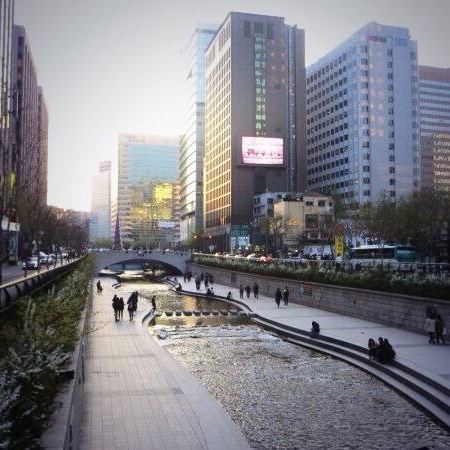 Mayor Jorge Elorza appeared with his team from Providence Planning to present a draft proposal for the 6/10 Connector Monday night. The plan took the form of a parkway.
Mayor Jorge Elorza appeared with his team from Providence Planning to present a draft proposal for the 6/10 Connector Monday night. The plan took the form of a parkway.
The looming context of the meeting was Governor Gina Raimondo’s September 7th announcement to rebuild the highway as-is. Though the bridges in question remain open to car and truck traffic, Gov. Raimondo and Rhode Island Department of Transportation Director Peter Alviti have maintained that the condition of the bridges creates an emergency situation in which the planning process must be severely curtailed. On the 7th, Director Alviti stated that the surface boulevard was “dead”. [It seems like this would be well known, but for full disclosure, that boulevard proposal came through the group Moving Together Providence, of which I am one founding member].
If there had been any hopes that the City of Providence would reignite the boulevard proposal, it did not happen Monday. The parkway plan honed very close to the design of a highway. The city’s plan made a number of changes to the RIDOT proposal that improved neighborhood connectivity through biking and walking access.
I’m going to take off my objective journalist hat and comment on some things I liked and did not like, as well as some things I continue to have questions about, as we move forward.
Good: Reclaiming Land
While the parkway continues to take up an extraordinary 240’ of width, the city’s plan nonetheless reduces the footprint in places to half of what the highway would be. This has allowed the city to claim fifty of the seventy acres originally expected to be developable under the surface boulevard proposal.
The Providence proposal reclaims significant land in Olneyville, with a phase two proposal to extend DePasquale Square into about half of the 13 acres of Federal Hill that were lost to the Dean Street exit/entrance ramps.
Good: Creating new connections for Smaller Streets like Magnolia and Tobey
As a former resident of Tobey Street, one of my favorite proposals was changing the Tobey Street on-ramp into a bridge connecting Federal Hill to Olneyville. Street grid connections like this are a good idea.
Bad: Continued Use of Traffic Pseudo-Science
Traffic engineers who are in any way honest understand that it does not make sense to do traffic counts on a road and then plan capacity for that roadway accordingly. Numerous highways have been removed and seen a significant part of the traffic that uses those highways disappear, and this is such a common occurrence that it is now a routine understanding. Given the political context of pressure from RIDOT to reify traffic counts, the City of Providence Planning Department did the logical thing, which was to base its various proposals on projections about how many cars would be on 6/10. This is going to make many of the otherwise reasonable proposals less livable. It’s a shame to see the boulevard proposal die on the western half of the roadway that inspired Cheonggyecheon.
Good: Preserved Space for Enhanced Amtrak and MBTA Upgrades
While Amtrak continues to look into whether to reorient the highly-traveled Northeast Corridor through Worcester instead of Providence, the Planning Department’s proposal to keep land open for enhanced rail travel is an important part of the economic and quality-of-life picture.
Bad: Stroad Design for Connecting Streets
The images used for connecting streets were four lane roads with anemic looking bike lanes alongside them. Urban streets should be two lanes, with even the most traffic-oriented streets getting two lanes with a turn lane. The bike lanes put in these proposals are anemically narrow (Dutch infrastructure goes for 4 meters to allow bikes to pass one another) and is without separation. These streets need a road diet.
Bad: Bait-and-Switch on the Roundabout
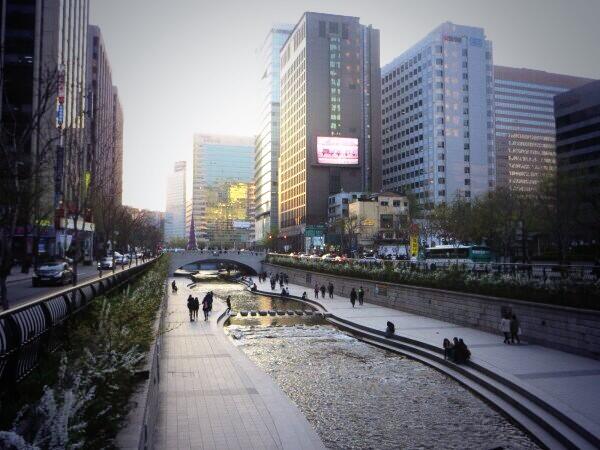 The Providence Planning proposal made use of a widely circulated image of a raised roundabout in the Netherlands, which serves bicycles crossing a Dutch highway. Problematically, this image was intended to go besides a proposal for a raised car roundabout to connect Routes 6 East and West and Route 10.
The Providence Planning proposal made use of a widely circulated image of a raised roundabout in the Netherlands, which serves bicycles crossing a Dutch highway. Problematically, this image was intended to go besides a proposal for a raised car roundabout to connect Routes 6 East and West and Route 10.
Roundabouts are not inherently a bad idea, but the use of this Dutch image is misleading. (Surface) roundabouts are an economical and safe way to connect roads that are high volume. (Would a raised roundabout that of course has many structures holding it up be cost-effective? That remains to be seen). They cost less than signalized intersections and usually allow more steady flow of traffic, causing them to be the default treatment in some states. Smaller roundabouts like the one carried out in Poynton, UK can be used in such a way as to create more pedestrian friendly areas while moving a surprisingly large number of vehicles. Larger roundabouts like those seen on Parisian boulevards can also carry a lot of traffic, but are being greatly curtailed as Paris attempts to revitalize the pedestrian connections around its major squares. Dutch bike design takes pedestrian and bike crossings away from roundabouts, while using them as a connection for cars.

In short, the roundabout should be understood as what it is: part of the parkway (which is really just a word for a scenic highway). The other connections need to put bike, pedestrians, and transit in the forefront.
Bad: No Real RIPTA Vision
While Providence Planning presented its efforts to remove cars from Olneyville Square via the raised roundabout as a way of improving through-flow of RIPTA buses, this follows the same induced demand logic that other traffic congestion schemes follow. Making a more direct connection between 10 N and 6 W will definitely take cars out of Olneyville immediately, but the pattern is that within a very short time traffic will fill that space and find equilibrium. So plans to create transit improvements need to acknowledge that. One way to improve transit-flow and make Olneyville more business friendly would be to disallow car through-traffic (allowing cars to visit and park at the edge, but pedestrianizing the center of the square is an idea that has its origins with Jef Nickerson of GCPVD). Having designated areas of the square for bus travel would then allow for better transit flow, though Providence Planning should be cognizant of the dos and don’ts about pedestrian spaces.
There also should be Bus Rapid Transit on the boulevard itself. I’ve pointed out in the past that while BRT does have some costs associated with it, a lot of the biggest costs going along with the RIDOT BRT proposal were added lanes for the BRT, and skyway bridges to connect pedestrians to center stations on a highway. A parkway continues to be a road designed with high speeds in mind, and I’m not certain how BRT could be best handled on a roadway like this, but I think it should be explored.
Getting Mugged by RIDOT
Two television stations and two newspapers asked me what I thought of the plan, and I compared it to a mugging. The Rhode Island Department of Transportation has very transparently used safety concerns about the Huntington Bridge to torpedo normal rules of process for deciding what to do with the highway. Essentially, Providence Planning has its back against the wall, and RIDOT is saying, “Your money, or your life?” Given that very limiting context, what Providence produced was a reasonable compromise that I can live with, in the same way that I accept other unpleasant realities forced upon me. I think the plan is leaps and bounds ahead of RIDOT’s proposal, but that’s not setting a high bar.
]]>Deprecated: Function get_magic_quotes_gpc() is deprecated in /hermes/bosnacweb08/bosnacweb08bf/b1577/ipg.rifuturecom/RIFutureNew/wp-includes/formatting.php on line 4387
Deprecated: Function get_magic_quotes_gpc() is deprecated in /hermes/bosnacweb08/bosnacweb08bf/b1577/ipg.rifuturecom/RIFutureNew/wp-includes/formatting.php on line 4387
Deprecated: Function get_magic_quotes_gpc() is deprecated in /hermes/bosnacweb08/bosnacweb08bf/b1577/ipg.rifuturecom/RIFutureNew/wp-includes/formatting.php on line 4387
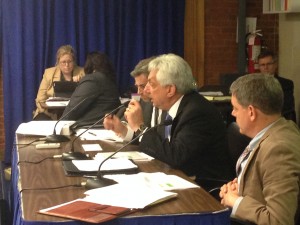
Director Peter Alviti of RIDOT recently stated his own version of reality about the 6/10 Connector when he said that, “Hypothetical plans or other scenarios could be explored in the world of theory, but in the world of reality we are facing we now need to address this structurally deficient problem.”
Alviti’s words are dismissive of basic commuting and engineering realities. It’s not really clear why spending $5-6 million to temporarily brace the Huntington Bridge would be unacceptable since it would open up time to discuss plans that may save the state hundreds of millions of dollars on the 6/10 Connector. Be that as it may, Alviti’s insistence that boulevard experts across the country are fanciful imagineers got me thinking about the most recently departed icon of imagination. As the City of Providence fights back against RIDOT, it’s going to have to take a page from the book of Willy Wonka. And no, not the Johnny Depp version, the real thing.
Every child loves Willy Wonka and the Chocolate Factory but it takes adult eyes to see one of the key lessons of the movie. My uncle pointed out to me growing up that what’s funniest to adults about the Gene Wilder representation of Wonka is that he never seems to raise his voice when the time is appropriate. This was obvious to my uncle, the father of four girls, because as a parent he understood how ineffective Wonka was being, and read that it was intentional.
Help. Police. Murder.
Kevin Proft, whose excellent pieces in Eco RI have put me to shame month after month for their fine-toothed journalistic detail on 6/10, deserves credit again for his excellent piece juxtaposing the various statements of RIDOT Director Peter Alviti has made before and after the supposed “emergency” that Gov. Raimondo announced Sept. 7th. But deep inside this sharp critique of Raimondo and Alviti is an important statement about Mayor Jorge Elorza as well:
Mayor Jorge Elorza and the city are pushing back, lightly. The mayor agreed to be at the governor’s press conference, and was commended twice by Raimondo for his support of her decision.
“I want to thank all of the mayors who have come together today in support of this. Mayor Elorza … it’s been a pleasure to work with you,” the governor said at the start of her remarks.
It’s unclear how supportive the mayor actually is. In his own remarks at the Sept. 7 press conference, he noted the importance of safe infrastructure, but said public safety doesn’t need to come at the expense of the city’s needs.
“While we know the bridge must be addressed in short order, we remain enthusiastic about the opportunity to collaborate with the state on the options to enhance and improve the 6-10 corridor as a whole,” Elorza said. “RIDOT, the city, and the community have all articulated a larger goal for this project including enhanced mobility options, improving the quality of place and quality of life in and around the corridor, and opening up new areas of economic development and jobs.
“We can invest these dollars in a way that ensures the safety of this roadway and also enhances the livability of this entire corridor. It’s our responsibility to advocate for the smartest investment of these dollars.”
Mayor Elorza can’t ride this fence for long. Though everyone agrees that he supports the boulevard, what counts is not just the words that are said, but the tone and manner in which they’re said.
Eventually Wonka finds his voice.
“It’s all there, black and white. Clear as crystal. You STOLE Fizzie Lifting Drinks. You bumped into the ceiling which now has to be washed and sterilized, and so you get NOTHING. YOU LOSE. GOOD DAY, SIR.”
We’re at a delicate place, and theatrics matters. Governor Raimondo doesn’t have the facts behind her, and nor does Director Alviti. There is no reason why stabilizing the Huntington Bridge entails curtailing the rights of Providence residents to participate fully in the public process and see their vision built. But facts don’t matter. Theater does. The mayor needs to learn from the late Gene Wilder and put a bit more magic in his step.
Mayor Elorza has been taking on a lot of issues. He’s fighting hard on Liquified Natural Gas, and just unveiled an ambitious plan to fight the root causes of poverty and homelessness near Kennedy Plaza. These deserve praise.
But it’s time to do the same on 6/10. If not, we’ll be stuck with this design for 75-100 years, and no one reading this will be able to affect change in their lifetimes.
Mayor Elorza has been taking on a lot of issues. He’s fighting hard on Liquified Natural Gas, and just unveiled an ambitious plan to fight the root causes of poverty and homelessness near Kennedy Plaza. These deserve praise.
But it’s time to do the same on 6/10. If not, we’ll be stuck with this design for 75-100 years, and no one reading this will be able to affect change in their lifetimes.
To quote Wonka: “We are the music makers, and we are the dreamers of dreams.” It might seem silly, but dreams have greater power to motivate people to action than facts. It’s time to make a stronger statement. Show some imagination! Call a press conference at the 6/10 Connector. But speak up.
]]>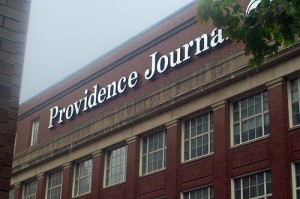 The Providence Journal editorial board posted a piece praising Governor Gina Raimondo for her decision to ignore the public process and the recommendations of national and local experts to fast-track the reconstruction of the 6/10 Connector.
The Providence Journal editorial board posted a piece praising Governor Gina Raimondo for her decision to ignore the public process and the recommendations of national and local experts to fast-track the reconstruction of the 6/10 Connector.
The Projo is, as a journalistic entity, free to make whatever statements it wants on any issue. The problem with the Projo’s editorial is that it is wrong on basic facts that all parties agree to. Quoth the Projo:
Gov. Gina Raimondo, thus, did the right thing by responding boldly to new evidence that bridges along that stretch are in perilous condition, putting the public’s safety at risk. She announced Wednesday that the state must repair these crumbling structures as quickly as possible.
In doing so, she had to pull the plug on an extravagant $595-million state Department of Transportation plan to cap the highway and knit back together neighborhoods that have been disconnected for decades with a new surface boulevard. That plan would have taken longer and cost more than simply fixing the bridges.
Three plans have been considered during the 6/10 Connector public process: rebuilding the highway as-is, rebuilding the highway with a cap over it at certain crossings, and a surface boulevard. The “rebuild with a cap” option, though better described as a highway plan, has been labeled by the Rhode Island Department of Transportation (RIDOT) as a “highway-boulevard hybrid.” Hence the confusion.
Everyone agrees that the surface boulevard would be the cheapest option of the three. That option, as outlined by community group Fix the 6/10, would cut down the amount of infrastructure spending needed to complete the project, while restoring the grid to drivers:
Rebuilding a highway in the 6/10 corridor, especially if it involves a cap, will cost at least $600 million, hundreds of millions more than a surface alternative. A surface option will cost taxpayers much less, making resources available for other projects throughout the state. Further, the ongoing maintenance costs of the highway option will burden our children with billions of dollars of maintenance and replacement costs. A surface road option will also unlock dozens of taxable acres for development, improving the region’s fiscal health.
In a Cranston public forum on the 6/10 Connector, Eco RI news documented that RIDOT officials intentionally spun the capped highway option as best, holding information that would favor the surface boulevard close to their chest unless specifically grilled on it:
RIDOT officials routinely downplayed instances where the boulevard option compared favorably to the capped-highway idea. At the meeting in Olneyville, it wasn’t until ecoRI News asked about the relative costs of the options — more than an hour into the meeting — that RIDOT revealed the boulevard option would cost taxpayers less. The difference remains undetermined, as RIDOT hasn’t calculated the cost of the boulevard option.
If the Projo had made such an error in a news article, it would be a problem. But for an editorial whose thesis is that the governor is making the tough decisions needed to save money, mistaking two of the three options on the table for one another, and then getting the costs of the options wrong calls for a full retraction.
~~~~
]]>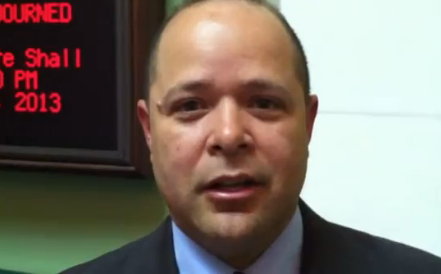 Governor Gina Raimondo may have acted too hastily when she took off the table the idea of transforming the 6/10 connector into a boulevard, according to Providence state Senator Juan Pichardo.
Governor Gina Raimondo may have acted too hastily when she took off the table the idea of transforming the 6/10 connector into a boulevard, according to Providence state Senator Juan Pichardo.
“The people who live in these areas were counting on the plans to reconnect the neighborhoods after being divided for so long by the highway,” Pichardo said in a recent news release. “This is a decision that will have a major impact on the daily lives of many people, and I’m concerned that it was made too hastily.”
Pichardo’s press release referred to the boulevard proposal as the “plan to reunite the neighborhoods.”
He said, “The benefit this project would have on the people in these neighborhoods just cannot be calculated. It’s rare that a government proposal gets this kind of support from the community. This project would have gone a long way to making the city more inclusive, ending decades of disenfranchisement that have been brought about in these neighborhoods. It’s more than a little disconcerting that something so positive for the whole city could be so quickly and so arbitrarily dismissed at a moment’s notice.”
Transportation advocates have been pushing to transform the 6/10 connector, which is in desperate need of repairs, into a boulevard – as other American cities have done when highways that cut through urban neighborhoods have needed major repairs. Providence Mayor Jorge Elorza is supportive of this concept. RIDOT is not. Last week, Raimondo said the overpasses are in such dire need of repair that the state cannot wait to consider the boulevard idea.
“I truly hope the state will reconsider and take into consideration the concerns and desires of an entire community, instead of repeating the mistakes of decades past by recreating a citywide scar on the landscape that has such a negative impact on the lives of so many.”
While Gov. Raimondo made remarks at a recent RIC event signaling her openness to accept any proposal that was safe, affordable, and not a traffic problem, a later statement through a spokesperson doubled down on her commitment to rebuild the highway as-is, with the caveat of adding a bike lane (on a highway?), building an additional ramp (i.e., expanding the highway), or putting in Bus Rapid Transit (part of both the RIDOT and City of Providence proposals).
Providence Planning will continue to take public feedback at 610Connector@providenceri.gov.
]]>The (non?) reversal was more of a whimper than a bang, because it contained significant caveats. But those who see a sustainable future for the corridor should press the governor to stick to her commitments going forward.
Rhode Island Bicycle Coalition activist Alex Krogh-Grabbe asked the governor what she would do on 6/10 around 5:00.
Gov. Raimondo said that if the City of Providence completes its public forums within the 60 day time frame she has outlined, she will honor their plan, so long as it is affordable and does not create safety issues for the bridges by delaying work.
The governor also gave herself breathing room for the future in laying out a caveat around traffic management.
While RIDOT officials have described the 6/10 boulevard as a traffic impediment, it’s clear that it would not be. The famed Champs Elysées in Paris carries as many cars as 6/10, while also accommodating 500,000 pedestrians a day.
Think about this highway boosters: Paris’ famed Champs-Elysees handles same traffic volume as 6-10 Connector.https://t.co/XIMM6hdrAU
— katherine gregg (@kathyprojo) August 31, 2016
Even more impressively, the city of Seoul, South Korea removed a raised highway above the Cheongyecheon River. At 160,000 cars a day, the Cheongyecheon Freeway carried 60% more cars than the 6/10 Connector, but Seoul didn’t even replace it with a boulevard. They just created a river park.
#Seoul view: Former highway with 160K cars/day, now a park with 75K visitors & 113K new jobs along it: pic.twitter.com/mn0KkE19Il
— Brent Toderian (@BrentToderian) April 23, 2015
The irony might be pressing as is, if it weren’t for the fact that Seoul officials sent observers to Providence before redesigning their highway, in order to see Waterplace Park– essentially the eastern edge of Route 6.
The reality is that traffic engineers have understood since the 1970s that urban highways create their own traffic mire, and that removing them does not worsen traffic congestion. The trick is getting RIDOT to admit this known fact. It’s hard to convince a person of something when their salary depends on them not understanding it.
Mayor Elorza will continue to take public feedback in order to aid his Planning Department in pushing for a boulevard. If you have something to share, please send your thoughts to 610connector@providenceri.gov.
Update:
Through spokesman Mike Raia, Raimondo’s office backed away from its statement to Krogh-Grabbe, saying it did not reverse its position on the need to repair overpasses on the 6/10 connector immediately, thus ending the debate on replacing it with a boulevard instead.
“She hasn’t backed away from her announcement, as RI Future is reporting,” said Raia. “This is a public safety decision. We are not considering a boulevard.”
Raia added:
“[The governor] announced three things:
“Move forward immediately with an in-kind replacement of the Huntington Ave bridge.
“Immediately start quarterly inspections of all the bridges.
“Reached an agreement with Mayor Elorza for his public input process to conclude quickly to allow RIDOT to issue RFPs by the end of the year.
“She said during the presser and again on Channel 10 that she is willing to consider modifications to a simple replace in kind for the remaining bridges as long as they do not cause any additional delay (these modifications might include a bike lane, BRT, a future project to connect 10N with 6W).”
~~~~
]]>The assembled crowd of 200 people at Tuesday night’s 6/10 Connector community meeting were unequivocal: no highway should be rebuilt along the corridor. It found a receptive if demur audience in Providence Planning Department and Mayor Jorge Elorza. RIDOT and Governor Gina Raimondo’s Office appear to be the only agencies backing the highway rebuild after the loss of a federal grant for the billion dollar project.
https://twitter.com/TransportPVD/status/770769768815132672
RI Future has been among several area publications that have called on Mayor Elorza to take a more direct stance on the project. While the mayor’s office has clearly favored a boulevard approach to 6/10, it hasn’t yet sought direct conflict with RIDOT or Governor Raimondo’s office. Following the rejection of a federal grant RIDOT intended to use towards part of the 6/10 corridor, statements from the agency have focused on the dire need to complete the highway rebuild with a minimum of public input. Read past coverage Tear It Down: Pictures of Our Potential 6/10 Future The Drivers’ Argument for the Boulevard On Tuesday night, Mayor Elorza did not seek direct conflict with the agency, but did refer to the 6/10 Connector as “really a Disconnector”, a sign of his preferences. In a Projo report leading up to the Providence meeting, RIDOT spokesperson Charles St. Martin bristled in his emailed response to questions on the project:
As we stated before, we cannot continue to postpone this work,” wrote DOT spokesman Charles St. Martin in an email. “Thanks to the passage of Rhodeworks, Rhode Island has $400 million in committed state and federal funding to draw from to address the Route 6-10 interchange. RIDOT is evaluating its options to tackle this problem and will soon present a recommendation for next steps. No decisions have been made at this time.”
This brings us to an important question: When is Gov. Raimondo’s office going to see the writing on the wall and redirect the agencies under her charge to better priorities? The assembled crowd was almost unanimous in its priorities. The process sat small groups at tables to outline ideas and present them. Each group, to the one, came up with some form or other of the following priorities:
- New housing
- Non-displacement of current residents while bringing in new residents
- Better outreach & a more welcoming process for Latino residents
- A full and complete bike and pedestrian network
- More green space
- Rapid transit to connect Providence within and without its city borders
- No highway
The groups varied in how they phrased these goals, but each group essentially outlined the same things. Notable about the meeting was the presence of individuals from communities like Cranston, Pawtucket, and Central Falls, whose citizens might have been more inclined to favor a highway than those having one built next to them. But those from outside Providence also favored the boulevard option. Among the attendees was Cranston at-large city council candidate Kate Aubin, who has made removing the 6/10 Connector a central tenet of her candidacy.
https://twitter.com/TransportPVD/status/770764144735838208
While Aubin is running on a progressive ticket, conservative Rhode Islanders also attended, questioning the priority of rebuilding 6/10 as-is. Rhode Island Center for Freedom & Prosperity’s Lawrence Gilheeney tweeted:
also, here's some pictures of last nights forum pic.twitter.com/mx3FGwvePa
— Larry Gillheeney (@LGillheeney) August 31, 2016
More pointedly, Brian Bishop, of the taxpayers’ rights group OSTPA spoke to the unnecessary waste of rebuilding the highway, drawing the night’s first laughter and applause:
https://twitter.com/TransportPVD/status/770775028090613760
Bishop, who owns properties on the East Side as well as a farm in Coventry, said that he was a “car person” and that others “can handle the bikes,” a friendly jab at non-OSTPA member Hugo Bruggeman, who held the table’s priority list and spoke to bike infrastructure like his home in the Netherlands. Bishop described the highway “hybrid” that RIDOT has been pushing over the Providence Planning-preferred boulevard as “brought to you by the same people who want to rebuild it again.” The audience roared with laughter at RIDOT’s expense.
With federal grants figured into the mix, RIDOT’s hybrid-highway proposal would have cost upwards of 80% of toll funds. Without that funding, it’s quite possible that rebuilding the highway as-is could put all other state projects on the back burner. Conservatives like Bishop and liberals like Aubin equally question the validity of this priority, despite living outside the city.
Which brings us back to a pointed question: Who exactly does favor the 6/10 Connector as a highway, other than RIDOT and Gov. Raimondo’s office? As a more politically diverse coalition coalesces around opposition to the plan, Gov. Raimondo is going to have to make some decisions soon.
~~~~
Correction: A previous version of this article erroneously named Lawrence Gilheeney’s group the Rhode Island Center for Freedom & Progress. It is the Rhode Island Center for Freedom & Prosperity. No doubt a liberal Freudian slip on my part. . . :-) Corrected.
]]>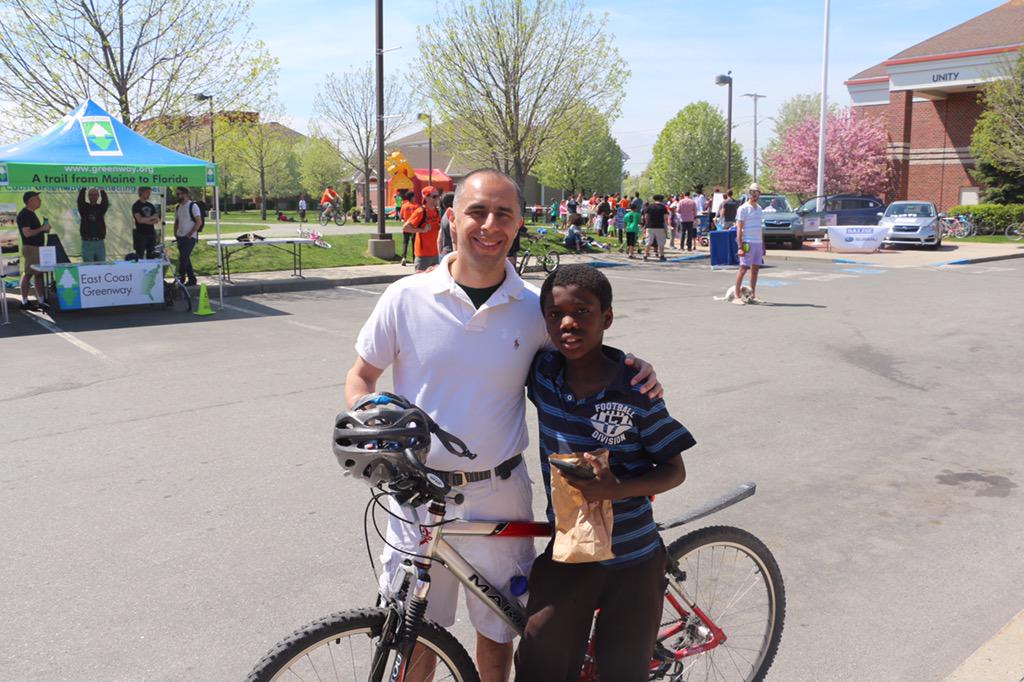 Mayor Jorge Elorza bikes to work everyday, and takes part in frequent night rides with community members. By all accounts the mayor is supportive of bicycling. However, Providence has made next to no progress on bike infrastructure during the two years the mayor has been in office. This needs to change.
Mayor Jorge Elorza bikes to work everyday, and takes part in frequent night rides with community members. By all accounts the mayor is supportive of bicycling. However, Providence has made next to no progress on bike infrastructure during the two years the mayor has been in office. This needs to change.
Providence has seen the mayor step up on some issues, and his vocal leadership has had an effect. Just recently, Mayor Elorza spoke eloquently to the harm of liquefied natural gas (LNG) power plants, a move which put him in direct contradiction with Governor Raimondo. This move came after the Sierra Club of Rhode Island challenged the mayor to speak up clearly on the issue. I am making the same request.
Where is the bike infrastructure, Mayor Elorza?
We cannot expect mass cycling to take root in Rhode Island without our core cities establishing bike routes that are suitable for eight year olds, 80 year olds, and everyone in between. If we’re going to provide routes that are safe for people in wheelchairs and rascals, we need bike routes, like what the Dutch and Danish have. Doing this can help us make more efficient use of our school bus funding, our sidewalk funding, our parking, and improve business outcomes for small business.
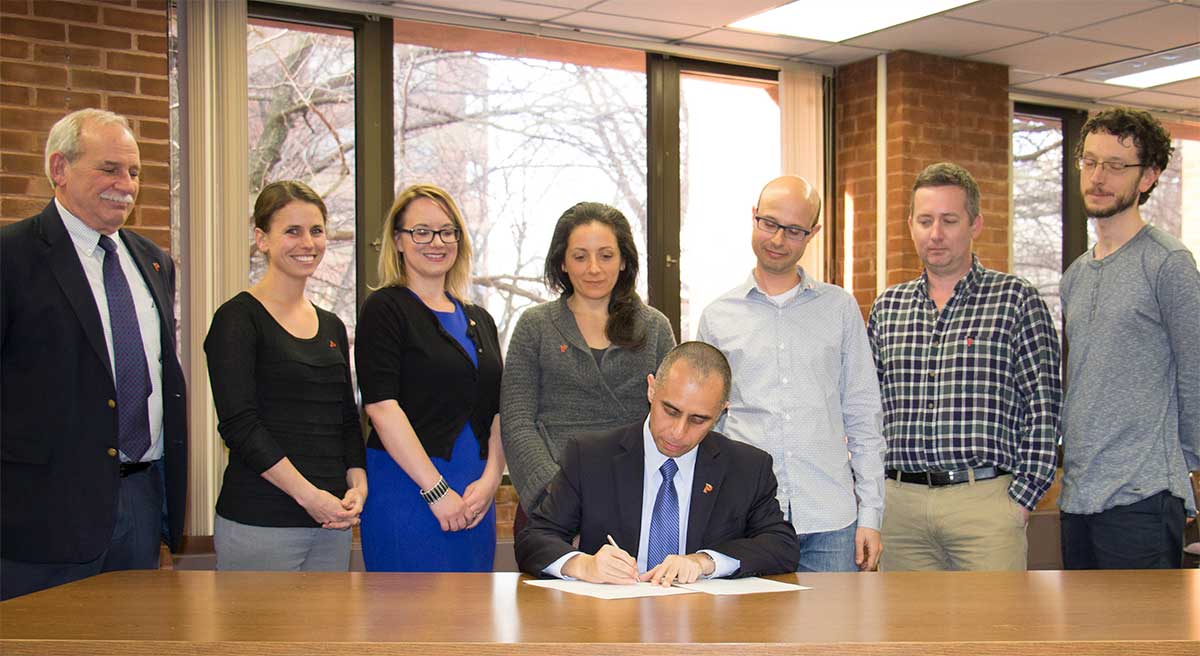
The mayor has pushed some reform. The city’s Bicycle and Pedestrian Advisory Commission currently receives advanced notice of city street projects, and its review of those projects has brought piecemeal changes to sections of street as they’re repaved. Many project reviews include only tiny sections of street, and nothing has yet been accomplished beyond paint, either through door-zone bike lanes, or even worse, sharrows. But this is not enough. To be frank, if Providence is not going to become a charming patch of shallow ocean in the next century, we need concerted action now.
What do community members demand?
A demand is a challenge that comes as an honor only to those politicians who warrant it. Mayor Elorza has objectively not accomplished what needs to be accomplished in his first years of office, however, he has demonstrated himself to be someone who, with pressure, might accomplish those goals. Be honored, Mayor Elorza. You’re being called to the challenge.
The mayor must work to design a full network of protected bike lanes on the major arterials of the city. A starting point for this would be 50 miles of infrastructure, which we estimate would take only 3% of on-street parking to achieve.
The mayor must also work to create “bike boulevards”- routes that are low-traffic and low-speed, off of the major arterials. These are not substitutes for protected bike lanes, which are needed to reach jobs and shopping opportunities in commercial areas, but they are majorly important improvements to help make our neighborhoods safer for school children.
The mayor’s office has been supportive of remaking the 6/10 Connector as a boulevard, but as yet has not sought public conflict with RIDOT and the governor’s office about their intransigence to community needs. We need the mayor to pick this fight, in a direct way, just as he did on LNG. It’s understandable that the mayor wishes to advocate behind the scenes, but what will bring life to this issue is a top official speaking openly about the poor priorities RIDOT is putting forward. Without that, the 6/10 Connector continues to take a back-burner position in the news cycle. Speak up, mayor! Put the state government on notice!
These projects must be funded. The city’s $40 million bond includes transportation and non-transportation priorities, but among transportation priorities only 17% of funding is going to non-car priorities, mainly sidewalks. The city must spend in proportion to its population of non-car owners (22%), and it must make good use of those funds to make sure that biking is considered a high priority.
We’ve seen you act before, mayor. We have faith in you. Step it up! We need you to take action. The bike rides aren’t enough. We’re here to vote for you and to back you up when you are ready to do this.
It’s time.
~~~~
]]> Former Providence mayor Joseph Paolino’s media blitz around homelessness should be taken with a grain (or two, or three) of salt. In 2014, Paolino spoke with James Baar at The Projo (“The Seven Deadly Sins of Downtown Providence”, April 29, 2014) to outline his angst over panhandling homeless people and low income bus riders, suggesting a set of recommendations that show the casino magnate and parking lot landlord’s true political center. As I pointed out at the time and more recently, what really stretches credulity about Paolino’s 2014 proposals wasn’t simply their blithe disregard for the poor, but the barking way that Paolino assumed the city could just take up major new financial liabilities without any realistic stream of money to pay for them. With such extravagant ideas as removing Kennedy Plaza entirely, building a giant underground garage under it, and doubling the size of Burnside Park– all while policing the area to get rid of “vagrants” and completely banning potholes (Just “Do it!” yelled Paolino through the voice of Baar), you would think the city must be swimming in money. The kind of money that could, of course, help resolve the root causes of homelessness.
Former Providence mayor Joseph Paolino’s media blitz around homelessness should be taken with a grain (or two, or three) of salt. In 2014, Paolino spoke with James Baar at The Projo (“The Seven Deadly Sins of Downtown Providence”, April 29, 2014) to outline his angst over panhandling homeless people and low income bus riders, suggesting a set of recommendations that show the casino magnate and parking lot landlord’s true political center. As I pointed out at the time and more recently, what really stretches credulity about Paolino’s 2014 proposals wasn’t simply their blithe disregard for the poor, but the barking way that Paolino assumed the city could just take up major new financial liabilities without any realistic stream of money to pay for them. With such extravagant ideas as removing Kennedy Plaza entirely, building a giant underground garage under it, and doubling the size of Burnside Park– all while policing the area to get rid of “vagrants” and completely banning potholes (Just “Do it!” yelled Paolino through the voice of Baar), you would think the city must be swimming in money. The kind of money that could, of course, help resolve the root causes of homelessness.
The 2014 priorities listed by Paolino remain poor uses of city or state funding, but the former mayor’s softer tone on homelessness opens up an opportunity to hold his feet to the fire and demand some changes. Most recently, in an interview with The Projo’s Edward Fitzpatrick, Paolino says he wants the city to avoid the “Giuliani way” of removing homeless people, and look to root causes. Will Paolino stay true to his word?
Here are some things Paolino can back to show that he’s serious.
A parking lot tax, with a refund to housing costs
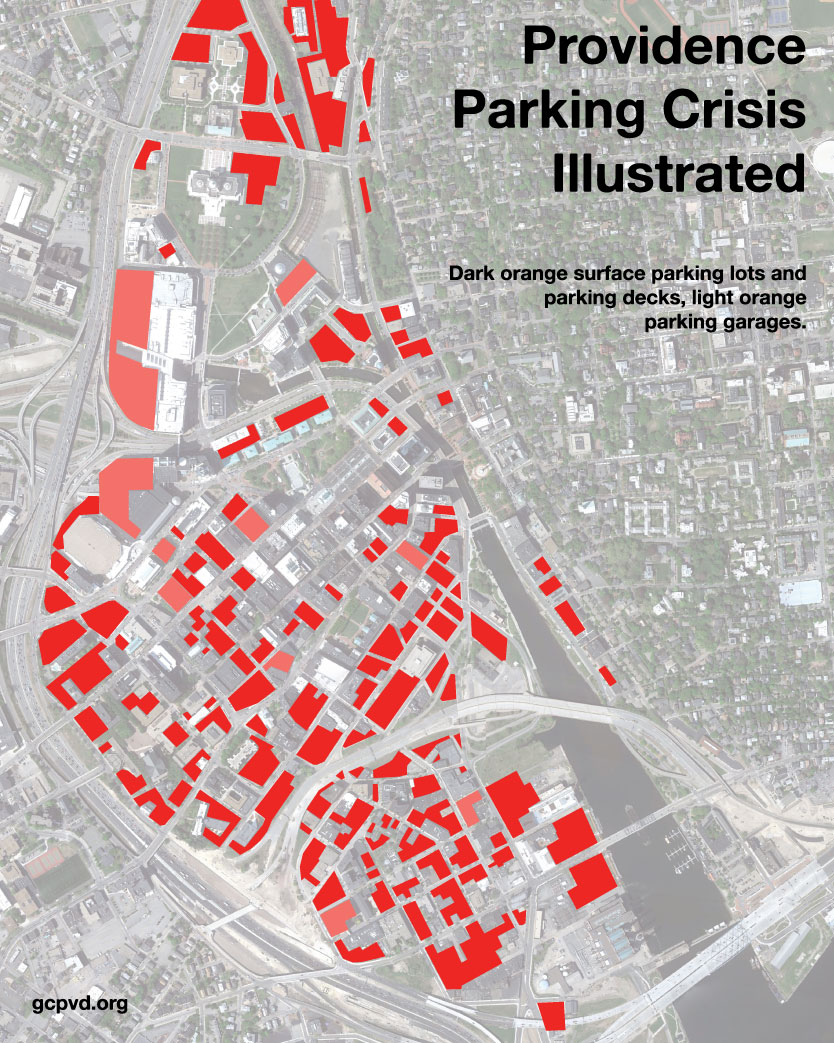
Paolino has large holdings in downtown parking lots. Essentially these are land speculation projects. It makes sense to hold onto prime land in the city, earning money off of commuters who park there, until a perfect skyscraper project comes along for those plots of land. Parking lots do pay property taxes, but because a surface lot is not valued highly, this gives speculators the best of all worlds– an easy short-term revenue stream, low taxes, and a lottery ticket that is likely to be worth a lot of money in the future.
I’ve argued in the past that putting a tax on surface parking would change the balance of this math. Land speculators like Paolino would be inclined to build something– anything– to hold the space until larger projects could come, instead of pimping parking lots. A developer may prefer a skyscraper, and in the long-run that may be the best thing for the city as well, but having rowhouses in the space while something else comes along means people have a place to live. As bigger projects form, the city could also require the continued tenancy of low income residents as part of mixed income development. This could itself help create more affordable housing. A tax on parking could and should also be refunded directly to properties adjacent to the parking, lowering the cost of business and residency in the city. Yet another way that this stream of revenue could considerably change the forecast for the poorest people would be if a portion of it was directly put towards housing vouchers for homeless individuals and families. Paolino has suggested that more money be put to shelters for homeless people, but what people truly need is permanent housing.
A parking lot tax would cost Paolino– he owns 11 lots. But if he’s serious about his statement that the business community needs to step up, endorsing this reform and pushing it through the business community would be one sincere step he could take.
Deregulation of single-family only zoning & parking minimums
Many Providence neighborhoods do not allow affordable housing, by law. The zoning code is full of arcane regulations designed to allow only what types of housing currently exist in a neighborhood. This is nothing like what happened in normal cities before the 1920s.
Providing affordable housing in Providence should partly be built around getting rid of some of these arcane rules.
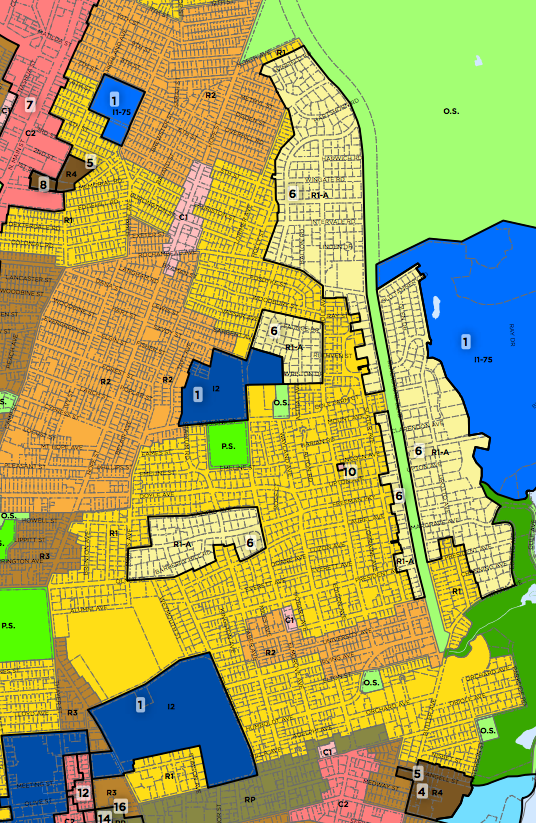
Parking minimums require that most residences have x number of parking spots per square foot of space. This both makes the housing itself more expensive, and also rules out building new housing on land that is taken up by parking.
Providence also has a number of neighborhoods that don’t allow anything but single-family homes. Sometimes these neighborhoods already have some houses that aren’t single-family, and they’ve been carved into the zoning as exceptions. The business community and city need to work together to eliminate zones like 1 & 1A, which don’t allow things like granny cottages, rowhouses, apartments, twins, duplexes, or triple-deckers. The business community and city also have to work together to end the practice of putting residency limits on students. Students bleed out into housing, making what affordable options that exist more expensive, and displacing people on the fringes of becoming homeless.
These are not issues that Paolino can be held accountable for, but in his new-found advocacy for the homeless, they should become centerpieces of policy change. Paolino should push zoning reform.
Transit at the center, not the fringes
While Paolino can’t be blamed for zoning, he can be held accountable for his long agitation against Kennedy Plaza as a bus hub. In 2014, as I stated, Paolino advocated for moving buses “to the fringes of the city” and getting rid of the bus hub entirely, to make it an underground parking garage.
People who become homeless often have serious problems that go beyond job access, but once they get on track, keeping a job is a very important stabilizing force. Transit is one of the most important ways to make sure that low-income people, who cannot afford cars, can have access to jobs.
I’ve had some online discussions with other transit advocates who point out that RIPTA should not be running all its routes through Kennedy Plaza. I agree with this criticism, and think we need an effort to put together a full network of bus routes like what Jarrett Walker designed in Houston, but I also think it’s clear this hasn’t been what Paolino meant in the past. Referring to buses as needing to be “at the fringes” is pretty clear about why the buses need to move– in this case, to take the sour image of poor people out of the downtown. Paolino’s business coalition needs to work to make transit a priority by spearheading efforts to give buses rights-of-way, improving frequencies of bus routes by funding RIPTA better, and updating the city’s poor pedestrian and bike layout to aid last-mile connections.
I’ve argued in the past that while there’s been a lot of action around maintaining free bus passes for elderly and disabled Rhode Islanders, that more attention needed to be put to making the bus system run efficiently and frequently (an argument I borrowed from Jarrett Walker as well). However, even in that piece, I argued that it was silly not to offer homeless people free rides on RIPTA. RIPTA has temporarily extended the free bus pass program pending funding, but business leaders like Paolino need to make RIPTA a long-term priority.
Supporting RIPTA, biking, and walking would be a big turnaround for Joe Paolino, but if he’s truly a reformed man with a vision to end the plight of the homeless, that would be what he needs to do.
And Scrooge was better than his word
I would be lying if I said that I trusted Joe Paolino’s softer messaging on panhandling in Kennedy Plaza. Over the years, many of Paolino’s priorities for the city have struck me as hostile to poor people and to non-drivers, couched in the kind of right-leaning identity politics one might associate more with Donald Trump than a former Democratic mayor of a blue-state city. But everyone can change. I will open my arms to Joe Paolino if he changes his ways. He needs to embrace the end of his parking empire as a way of speculating off of city land, support putting direct tax resources into more affordable housing, back zoning deregulation to stop the experiment of single-family-only neighborhoods, and back a robust RIPTA with bike and pedestrian infrastructure to support last-mile connections. His rhetoric has to move beyond temporary housing for homeless people, and towards permanent solutions.
As Charles Dickens would put it:
Scrooge was better than his word. He did it all, and infinitely more; and to Tiny Tim, who did not die, he was a second father. He became as good a friend, as good a master, and as good a man, as the good old city knew, or any other good old city, town, or borough, in the good old world. Some people laughed to see the alteration in him, but he let them laugh, and little heeded them; for he was wise enough to know that nothing ever happened on this globe, for good, at which some people did not have their fill of laughter in the outset; and knowing that such as these would be blind anyway, he thought it quite as well that they should wrinkle up their eyes in grins, as have the malady in less attractive forms. His own heart laughed: and that was quite enough for him.
God Bless Us Every One.
~~~~
]]> #NeverHillary is a bit too flippant to me. The point of an election is to pressure a candidate, and get results. We have gotten some movement in the right direction, thanks to Bernie Sanders. Still, for many voters, there are still significant reasons not to want to cast a vote for Hillary Clinton. Instead of yelling “Never Hillary!” let’s take a more nuanced stance. It’s time for #MaybeHillary.
#NeverHillary is a bit too flippant to me. The point of an election is to pressure a candidate, and get results. We have gotten some movement in the right direction, thanks to Bernie Sanders. Still, for many voters, there are still significant reasons not to want to cast a vote for Hillary Clinton. Instead of yelling “Never Hillary!” let’s take a more nuanced stance. It’s time for #MaybeHillary.
The #MaybeHillary movement is open to the idea that voting for a lesser evil is sometimes the right thing to do, but also seeks to push that lesser evil candidate to the maximum that is possible within the political situation. People who say that that’s already been done are ignoring Hillary Clinton’s very right-leaning (and sometimes rightwing) foreign policy stance, and her tepid stances on climate change.
The #MaybeHillary movement is also open to considering the relative strength or weakness of a Republican challenger. It should be agreed that we can’t allow a rightwing Republican like Donald Trump into office, but part of that equation should be constantly fine-tuning our assessment of just how likely his election is. With Republicans fleeing Trump for Clinton or sometimes even Gary Johnson, there is increasingly an opening to push Clinton to make sure she keeps and extends her progressive message.
The #MaybeHillary movement is also one that supports the idea of flexible strategies to reflect the differences of various states. Yes, it’s true that voting is a collective action, as Samuel G. Howard states, but in 2012, Barack Obama held Rhode Island by 27 points. Jill Stein would have to take that support, without Donald Trump losing any votes at all to the Libertarians, in order to act as a spoiler. And in a world where the Green Party did well enough to take 27 points of an election– even in a blue state– the political conversation on the Wednesday after election day would be one to look forward to.
Saying #MaybeHillary means not being aggressive and nasty to people who are voting for Clinton, because in an election like this one, who can blame voters for not wanting Donald Trump? Saying #MaybeHillary means being open to switching to Clinton if she satisfies enough major progressive pledges (for me, the two I think are most sorely missing are her foreign policy and climate change positions, but you can fill in your own in the comments section). Saying #MaybeHillary means having the kind of conversation with voters that can energize them to press the candidate for more in a viable way. The #NeverHillary movement shuts down conversations, and so does shaming people for voting their consciences. Let’s get people activated around issues, hold Clinton accountable, and get what we need.
]]>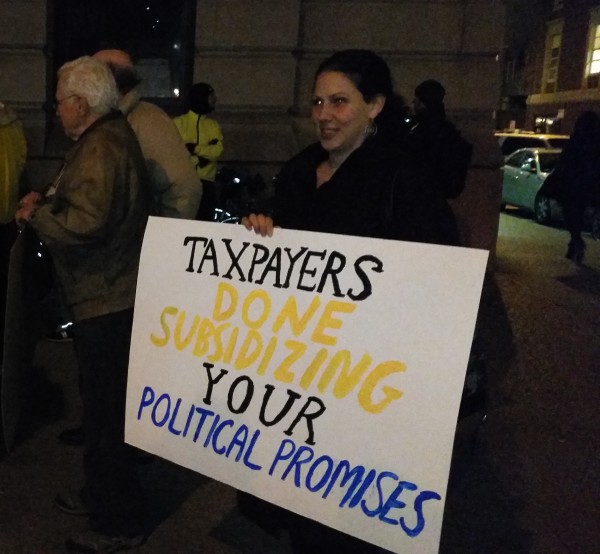
RI Future’s recent coverage of a tax stabilization agreement (or TSA) for Rising Sun Mills admirably pursues the idea of a fair tax system for all Providence residents. There’s a lot I agree with about this approach. At its roots, TSAs are an insider deal. But the logic behind TSAs makes a lot more sense than is obvious at a first glance. The goal for the city should be to establish a tax system that mirrors some of the features of TSAs, rather than carve out special agreements for the well-connected.
What is a TSA?
To begin with, what is a TSA? Tax stabilization can take many forms, but they’re usually agreements that require the owner of a property to pay the same taxes that were previously paid, though not more, in return for the property owner adding a new building or refurbishing an endangered one. (thus, a tax “stabilization”).
On the face of things, that arrangement sounds really unfair, but it makes more sense if you look at the costs that a building owner is supposed to cover with their taxes and think about how those costs change (or stay the same) after the refurbishment. An infill or renovation project in a city does not require a new sewer extension, but can be hooked up to existing lines. It does not require new streets. If it receives transit service, it’s usually on an existing line, and the new building will add ridership rather than adding miles of service area. A building being occupied may actually help to lower crime without more policing, and in any case it will be built within an existing police precinct. A building covered by an urban TSA will often be a solid building, perhaps even a historic renovation, that is intended to last a long time.
Contrast that to the typical suburban sprawl* project, like a Walmart. It will require acres of new land, and to function will need a sewer extension, gigantic new roads, or road and interchange expansions. It will add greatly to the surface runoff costs of the sewer system as well, with gigantic parking lots. Big box projects like Walmarts often demand transit service for their low-wage workers, but design everything about their facilities in order to defeat the efficiency of that service– after all, the customers and managers drive– delivering a transit service that costs a lot and delivers very little. Sometimes a single project will be the size of a small urban neighborhood, adding tremendous strain to traffic, and requiring a new police or fire precinct. For all the investment that is put into such a deal, the buildings the big box brings are meant to have a thirty year life cycle at most, and often the big box company will require land covenants that disallow competitors to move in if they should happen to leave the building (they often do leave the building, repeating this process).
Suburban projects look like a good deal because politicians won’t pay for all the additional costs that these projects bring. Those costs will accrue decades from now.
Urban and suburban communities both compete with each other to give away tax deals, and to be fair, urban TSAs are an insider deal just like any other. The politicians that prepare these deals don’t necessarily think about all the economic logic I presented above. The way they see it, the deal is about jobs for their ward. They care very little about the long-term effects. Urban TSAs happen to be a much better deal, but that’s not by design.
Fixing the TSA
Instead of creating TSAs for individual projects, we should make our tax system look a bit more like what a TSA tries to accomplish, but for everyone. A land tax should be a component of our tax system, used to offset a lower property tax. This isn’t exactly the same as a TSA. Under this arrangement, creating improvements to a property– adding buildings, fixing a roof– would still raise the value of the property and kick in more tax revenue from the property tax part of the tax model. But the land tax would stay the same– tied to the amount of land used and the resources consumed by that parcel.
Equity is a big concern under TSAs, not only for the fact that some can get a TSA and some can’t, but also because of the particular services that suffer in a city when not enough tax revenue is present. I would propose that the services paid for by the land and property tax sections of the tax code by bifurcated carefully. The land tax should pay for the things that resemble “pay for what you use” items– roads, sewers, transit, etc. The property tax should pay for things that we conceive of as “each according to their ability” services– libraries, schools, and other social services. By separating the budgets in this way, we ensure that when we tax a more valuable property, we’re tying that taxation to our ideal of sharing, rather than creating a slush fund to allow for wasteful infrastructure extensions.
Land taxes already exist in many places– my home state of Pennsylvania is one. They’re not a magic cure-all, and in order to fix our cities, we’re also going to have to stop subsidizing sprawl. Part of why I react to the criticism of TSAs is that the overwhelming nature of our subsidy mix is to ever-expanding consumption of undeveloped land for new strip malls or big boxes, cul-de-sacs and highways. The Rising Sun Mills project lost a tenant to Johnston because all the advantages of being in the suburbs– parking, big roads, etc.– are pre-paid features of life in America– while all the advantages of living in the city– walkability, community, and so on– are privatized goods to be bought and sold. We have to break that pattern. A land tax could be one step towards that.
~~~~
*”Suburban” is an ambiguous term, but here I mean suburbs that are totally car-oriented, cul-de-sac driven, post-1950s-style suburbs, rather than suburbs that have the form basically of a small walkable town that extends out from a city. Think Warwick or Johnston, rather than Bristol or Warren.
]]>